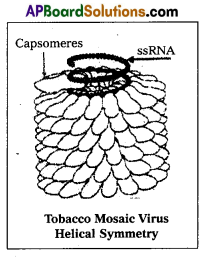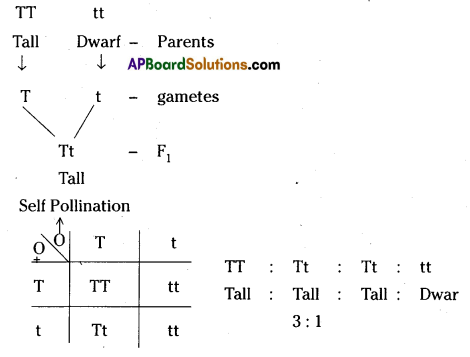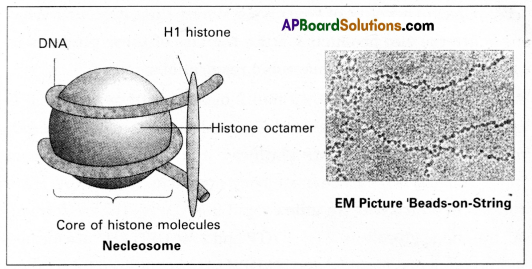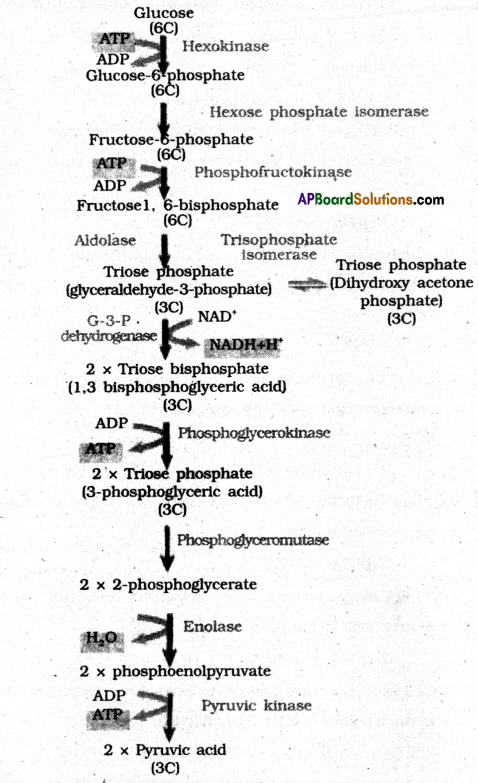Thoroughly analyzing AP Inter 2nd Year Botany Model Papers and AP Inter 2nd Year Botany Question Paper May 2017 helps students identify their strengths and weaknesses.
AP Inter 2nd Year Botany Question Paper May 2017
Time : 3 Hours
Max. Marks: 60
Note: Read the following instructions carefully:
- Answer all the questions of Section – A. Answer any six questions out of eight in Section – B and answer any two questions out of three in Section – C.
- In Section – A questions from Serial Nos. 1 to 10 are of ‘Very Short Answer type”. Each question carries two marks. Every answer may be limited to 5 lines. Answer all these questions at one place in the same order.
- In Section – B questions from Serial Nos, 11 to 18 are of ‘Short answer type”. Each question carries four marks. Every answer may be limited to 20 lines.
- In Section – C, questions from Serial Nos. 19 to 21 are of “Long answer type”. Each question carries eight marks. Every answer may be limited to 60 lines.
- Draw labelled diagrams wherever necessary for questions in Sections – B and C.
Section – A
10 x 2 = 20
Note: Answer all the questions.
Question 1.
Differentiate osmosis from diffusion.
Answer:
| Diffusion | Osmosis |
| 1. The movement of gases or molecules from high concentrated place to low concentrated place is called diffusion. | 1. The movement of water from low concentrated place to high concentrated place through a semi permeable membrane is called osmosis. |
Question 2.
Define the law of limiting factors proposed by Blackman.
Answer:
In a process participated by a number of separate factors the rate of of the process is limited by the factor which is present in minimal value is called law of limiting factor.
Question 3.
What are Pleomorphic Bacteria? Give one example.
Answer:
Some bacteria keep on changing their shape depending upon the type of environment and nutrients available are called
pleomorphic bacteria. Ex: Acetobacter.
Question 4.
Explain the terms Phenotype and Genotype.
Answer:
The physical or external appearance of a character is called phenotype. The genetic makeup of an individual is called Genotype.
![]()
Question 5.
Who proved that DNA is genetic material ‘What is the organism they worked on?
Answer:
Alfred Hershey and Martha Chase. They worked on Bacterio phages.
Question 6.
What is meant by Capping and Tailing?
Answer:
An unusual nucleotide (Methyl guanosine triphosphate) is added to the 5 end of hnRNA is called Capping. Adding of adenylate residues at 31 end of hnRNA is called Tailing.
Question 7.
What is Down Stream Processing?
Answer:
The product has to be subjected through a series of processes such as separation, and purification before it is ready to marketing are collectively referred to as Down downstream processing.
Question 8.
What is GEAC and what are its objectives?
Answer:
Genetic Engineering Approval Committee. It make decisions regarding the validity of Genetically modified research and the safety of introducing GM organisms for public services.
Question 9.
Give two examples of Fhngi used in SCP production?
Answer:
Candida utilis, Saccharomyces cerevisiae, Chaetomium cellulolyticum.
Question 10.
What are Fermenters?
Answer:
Large vessels in which microbes are grown in large numbers on an individual scale are called fomenters.
![]()
Section – B
6 x 4 = 24
Note: Answer any six questions.
Question 11.
“Transpiration is a necessary evil.” Explain.
Answer:
Beneficial effects:
- It helps in passive absorption of water.
- It also helps in passive absorption of mineral salts by mass flow mechanism.
- It is the main force for ascent of sap.
- It regulates the temperature of plant body and provides cooling effect.
- Maintain shape and structure of the plants by keeping cell Turgid.
Harmful Effects:
- Excessive transpiration makes the cells flaccid which retards growth.
- Excessive transpiration leads to closure of stomata thus obstructing gaseous exchange.
Question 12.
Write in brief how plants synthesize amino acids.
Answer:
1. Reductive amination: Ammonia reacts with α-keto glutaric acid and forms glutamic acid.

2. Transmination: In this transfer of an amino group from an amino acid to the keto group of a keto acid. Glutamic acid is the main amino acid from which the transfer of NH2 takes place and other amino acids is formed in the presence of transaminase.

Question 13.
Write briefly about Enzyme Inhibitors.
Answer:
The chemicals that can shuts off enzyme activity are called enzyme inhibitors. They are of three types.
A) Competitive inhibitors: Substances which closely resembles the substrate molecules and inhibits the activity of the
enzyme are called Competitive inhibitors. Ex: Inhibition of Succinic dehydrogenase by Malonate which closely resembles the substrate Succinae.
B) Non-competitive inhibitors: The inhibitors which have no structural similarity with the substrate and bind to an enzyme at locations other than the active sites, so that the globular structure of the enzyme is changed are called Non-competitive inhibitors. Ex: Metal ions of Copper, Mercury.
C) Feedback inhibitors: The end product of a chain of enzyme catalyzed reactions inhibits the enzyme of the first reaction as part of homeostatic control of metabolism is called feedback inhibitors. Ex: During respiration, accumulation of Glucose-6- phosphate occurs it inhibits the Hexokinase.
Question 14.
Write any four physiological effects of Cytokines in plants.
Answer:
- Cytokinins help to produce new leaves, and chloroplasts in leaves.
- Cytokinins initiate lateral shoot growth and adventitious shoot formation.
- Cytokinins help to overcome apical dominance.
- They promote nutrient mobilization which helps in the decay of senescence.
![]()
Question 15.
Explain the structure of TMV.
Answer:
TMV is most extensively studied plant virus. It is elongated rod-like. TMV is about 300 nm long and 18 nm in diameter with a molecular weight of 39 x 106 daltons. The capsid is made up of 2,130 protein subunits called capsomeres, arranged helically around a central hollow space of 4 nm. Each capsomere is made up of a single polypeptide chain with 158 amino acids. RNA (SS) contains 6500 nucleotides.

Question 16.
Explain the law of dominance using a monohybrid cross.
Answer:
Characters are controlled by discrete units called factors. They occur in pairs.In a dissimilar pair of factors pertaining to a character, one number of the pair dominates the other. The law of dominance is used to explain the expression of only one of the parental characters in a monohybrid cross in the F1 and the expression of both in the F2 generations. It also explains the proportion of 3: 1 obtained at the F2 generation.

Question 17.
Write briefly on Nucleosomes.
Answer:
- The negatively charged DNA is wrapped around the positively charged histone octamer to form a structure called nucleosome.
- A typical nucleosome contains 200 base pairs of DNA helix.
- Nucleosomes constitute the repeating unit of a structure in nucleosome called chromatin.
- The nucleosomes in chromatin are seen as beads-on-string when viewed under electron microscope.

Question 18.
List out the beneficial aspects of Transgenic plants.
Answer:
- Transgenic papaya is resistant to papaya ringspot virus.
- Bt cotton is resistant to insects.
- Transgenic tomato plants are resistant to the bacterial pathogen – pseudomonas.
- Transgenic potato plants are resistant to the fungi phytophthora.
- Transgenic tomato Flavr Savr is bruise resistant i.e., suitable for storage an transport due to delayed ripening and offers large shelf life.
- Transgenic golden rice is obtained from ‘Taipei’ is rich in vitamin A and prevents blindness.
- Male sterile plants of Brassica napus are produced to eliminate the problem of manual emasculation on reduce the cost of hybrid seed production.
- Basmati variety of rice was made resistant against biotic and abiotic stresses.
Section – C
2 x 8=16
Note: Answer any two questions.
Question 19.
Give an account of Glycolysis. Where does it occur? What are the end products? Trace the fate of these products in both aerobic and anaerobic respiration.
Answer:
Glucose is broken down into 2 molecular of pyruvic acid is called Glycolysis. It was given by Gustav embden, Otto Mayerhof and J.Parnas so called EMP Pathway. It occurs in the cytoplasm of the cell and takes place in all living organisms. In this, 4 ATP are formed of which two are utilized and 2 NADPH+H+ are formed. A the end of glycolysis, 2 PA, 2 ATP and 2 NADPH+H+ are formed as end products. The ATP and NAÐPH+H+ are utilised for fixation of CO2.
Glyclosis occur in cytoplasm, pyruvic acid, 2ATP 2 NADPH+ H are the end products. In aerobic respiration, pyruvic acid, 2 NADPH+H+ are completely oxidised through TCA cycle, ETS pathway and produce 36 ATP molecules. In Anerobic respiration, pyruvic acid is partially ôxidised results in the formation of ethyl alcohol and CO2.
Reactions :
1. Glucose is phosphorylated in the presence of Kinase to form glucose-6-phosphate.
Glucose + ATP → Glucose-6-phosphate + ADP
2. G-6P is isomerised to Fructose-6-phosphate in the presence of Isomerase
G-6P → F6P
3. Fructose 6 phosphate is phosphorylated in the presence of hexokinase to form Fructose 1, 6 Biphosphate.
G6P + ATP → F1,6 BiP+ADP
4. F 1,6 BiP undergoes cleavage in the presence of Aldolase to form 1 Dihydroxy acetone phosphate and 1 Glyceraldehyde-3 phosphate
F1,6BiP → DHAP+1G3P
5. DHAP does not undergo oxidation in further reactions, so gets isomerized to another G3P in the presence of Isomerase.
1DHAP → 1G3P
6. 2 molecules of G3P undergoes dehydrogenation in the presence of dehydrogenase to form 2 molecules of 1, 3 DPGA.
2G3P+2NAD+ → 2-1,3DPGA + 2NADH + H+
7. 2 mol. of 1, 3 DPGA undergoes dephosphorylation in the presence of phosphor Glycerokinase to form 2 mol. of 3 PGA
2- 1,3 DPGA + 2ADP → 2- 3 PGA + 2 ATP
8. 2 mol. of 3PGA are converted into 2 mol. of 2PGA in the presence of mutage.
2-3PGA → 2-2 PGA
9. 2-PGA looses water molecules to form 2-phosphoenol pyruvic acid in the presence of Enolase.
2-2PGA → 2-PEPA + H20
10. 2 PEPA mols. are phosphorylated in the presence of pyruvic kinase to form 2 pyruvic acid molecules.
2PEPA + 2ADP → 2ATP + 2PA

![]()
Question 20.
Give a brief account of the tools of recombinant DNA technology.
Answer:
Key tools are:
1) Restriction enzymes : Two enzymes responsible for restricting the growth of Bacteriophage in Escherichia cou were isolated in the year 1963. One of these added methyl group to DNA and the other DNA. The latter was called restriction endonuclease.
The first restriction endonuclease. Hind II which cut DNA molecule at a particular pair by recognising a specific sequence of six base pairs, called recognition sequence for Hind II. Today more than 900 restriction enzymes were isolated from over 200 strains of Bacteria each of which recognises a different recognition sequence.
E. CORI is a restriction enzyme in which, the first latter comes from the genus (escherichia) and the second two letters from the species of the prokaryotic cell (coli) the latter ‘R’ is derived from the name of strain. Roman numbers indicate the order in which the enzymes were isolated from the strain of Bacteria. Restriction enzyme belong to a larger class of enzymes called nucleases.
They are of two types:
- Exonucleases which remove nucleotides from the ends of the DNA.
- Endonucleases which makes cuts at specific location with in the DNA.
Most restriction enzymes cut the two stands of DNA double helix at different locations such a cleavage is known as staggered cut. E.CORI recognises 5’ GAATT3’ sites on the DNA and cut it between G & A results in the formation of sticky ends or cohesive end pieces. This stickyness of the ends facilitates the action of enzyme DNA ligase.
Cloning vectors: The DNA used as a carrier for transferring a fragment of foreign DNA into a suitable host is called vector. Vectors used or multiplying the foreign DNA sequences are called cloning vectors. Commonly used cloning vectors are plasmids, bacteriophages, cosmids, plasmids are extrachromosome circular DNA molecules present in almost all bacteria species. They are inheritable and carry few genes are easy to isolate and reintroduce into the bacterium (host).
Features required to facilitates cloning into a vector:
a) Origin of replication: (on) This is a sequence from where replication starts and any piece of DNA when linked to this sequence can be made to replicate within host cells. It is also responsible for controlling the copy number of the linked DNA.
b) Selectable marker: In addition to ‘on’ the vector requires a selectable maker, which help in identifying and eliminating non-transformants and selectively permitting the growth of the any transformants normally, the genes encoding resistance to Antibiotics such as Ampicillin, Chloramphenicol, tetra cycline or Kanamycin, etc. are useful selectable makers for E.coli.
c) Cloning sites: In order to link the alien DNA, the vector needs to have very few preferably single recognition sites for the restriction enzyme.
d) Molecular weight: The cloning vector should have low molecular weight.
e) Vectors for cloning genes in plants and animals: The tumour-inducing (Ti) plasmid of Agrobacterium tunifaciens has
now been modified into a cloning vector such that it is no more pathogenic to plants. Similarly, retroviruses have also been disarmed and are now used to deliver desirable genes into animal cells.
Question 21.
You are a Botanist working in the area of plant breeding. Describe the various steps that you will undertake to release a new variety.
Answer:
The main steps in breeding a new genetic variety of a crop are:
1. Collection of Variability: Genetic variability is the root of any breeding programme. Collection and preservation of all the different wild varieties, species, and relatives of cultivated species is a prerequisite for effective exploitation of natural genes available in the populations. The entire collection having all the diverse alleles for all genes in a given crop is called Germplasm collection.
2. Evaluation and selection of parents: The germ plasm is evaluated so as to identify plants with desirable characteristics. The selected plants are multiplied and are used. Purelines are created wherever desirable.
3. Cross Hybridisation among the selected parents: After emasculation (Removal of Anthers from bisexual flower of a female parent) the female flowers are enclosed in a polythene bag to prevent undesired cross-pollination. Pollen grains are collected from the male parent with the help of a brush and are transferred to the surface of the stigma and thus cross pollination is affected artificially.
4. Selection and Testing of superior recombinants: It involves selecting among the progeny of hybrids, those plants that
have the desired character combination. The selection process requires careful scientific evaluation of the progeny. Due to this, plants that are superior to both the parents are obtained. These are self-pollinated for several generations till they reach a homozygosity.
5. Testing, release and commercialisation of new characters: The newly selected lines are evaluated for their yield and other traits of quality, disease resistance, etc. It is done by growing these in research fields and recording their performance under ideal fertilizer application, irrigation, and other crop management practices. It is followed by testing the materials in farmers’ fields for at least 3 growing seasons at several places in the country, in all agroclimatic zones. Finally, they are distributed to farmers as a new variety.